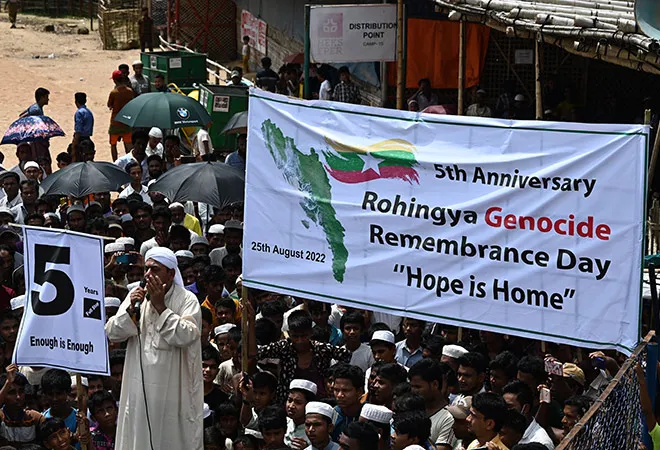
On 25 August, the exodus of close to a million Rohingyas to Bangladesh brought on by the rising violence in Myanmar’s Rakhine State, marked its fifth year. In 2017, the Rohingya people were driven out of Myanmar, which was acknowledged as ethnic cleansing and even genocide by the international world. Officials from the United Nations (UN) have stated that the country’s military leaders should be held accountable for the worst crimes against humanity. However, the conditions of these displaced people living in the peripheries have only worsened.
The displaced Rohingyas residing in the camps in Bangladesh are referred to as Forcibly Displaced Myanmar Nationals (FDMN). The FDMNs are individuals without a state and aren't considered as citizens in Myanmar or refugees in Bangladesh, since the nation is not a signatory to the 1951 Refugee Convention. The future course of action for the repatriation of the FDMNs looks dismal in the domestic run-offs in both, coup-torn Myanmar and the election-awaiting Bangladesh.
The FDMNs are individuals without a state and aren't considered as citizens in Myanmar or refugees in Bangladesh, since the nation is not a signatory to the 1951 Refugee Convention.
A sanctuary
Bangladesh, a lower-middle-class country, currently experiencing economic constraints has provided around 918,814 refugees sanctuary in the Cox's Bazar district and Bhasan Char Island. The Cox's Bazar has grown to be the biggest refugee colony in the world since 2017. The flood of new immigrants has placed a great strain on the already limited facilities and transitory settlements that have been further exacerbated by the COVID-19 pandemic and ever-evolving climate change. The perils of fires during the dry season followed by landslides, and flooding in the monsoons have increased. By March 2022, six fire incidents were reported, causing damage to life and property. The torrential rain and landslides, since the beginning of the monsoon season in 2022, have affected more than 13,000 shelters including learning centres, and WASH points. The Bangladesh government along with humanitarian partners including UNHCR, IOM, UNICEF, WHO, and WFP has been responding to these incidences by providing prompt life assistance to the people in need, and also by strengthening the response and coordination teams through the building of two-story shelters with space for fire breaks, conducting capacity building and mock drills. Several volunteers have also been recruited from the displaced population to fortify action points and redressal mechanisms.
Regarding health, in addition to containing COVID-19 other prevalent infections such as cholera, AWD, diphtheria, scabies, and dengue have been on a rise. Overall, the health sector has prioritised the provision of key health promotion activities through a network of over 1,400 Community Health Workers (CHWs) and 130 primary healthcare facilities. The challenge to provide coordinated response measures is affected due to limited resources. Thus, funding remains a major concern.
The flood of new immigrants has placed a great strain on the already limited facilities and transitory settlements that have been further exacerbated by the COVID-19 pandemic and ever-evolving climate change.
In addition to this, security conditions have been bleak. Murders, abductions, and trafficking of drugs and people have been rampant due to the presence of low opportunities within the camp areas.
Time to go back?
Rohingyas living in camps have been upfront in expressing they do not consider Bangladesh to be their country of origin and wish to return. The short-term policy focus of the Bangladesh government to get them repatriated shortly has resulted in limited opportunities within the camp areas in terms of livelihood, education, and restricted movement of the Rohingyas. The military coup in Myanmar puts the future of those living within the camp areas in limbo.
Previous attempts at repatriation have failed since the Rohingyas rejected the idea of going back if they are not awarded complete citizenship rights or protection. This stems from the fear that the violence is not over and they will be forced to flee again. These fears have only been exacerbated by the military coup last year. Although after the coup, there were talks of the possibility of repatriation, they did not include the entire population who escaped Myanmar in 2017 but rather a handful of Hindus among thousands of Muslims.
In addition to this, comes the question of resettling. It is well known that the villages where the displaced people once lived were razed by the Junta. Thus, the only viable option is to go back to “resettlement camps” surrounded by barbed wire and manned by military soldiers in Rakhine State. Already 135,000 displaced Rohingyas are surviving for the past decade in such open-air settlements without any rights or opportunities.
The short-term policy focus of the Bangladesh government to get them repatriated shortly has resulted in limited opportunities within the camp areas in terms of livelihood, education, and restricted movement of the Rohingyas.
Conditions required
According to Noeleen Heyzer, the United Nations Special Envoy of the Secretary-General on Myanmar, much of the onus of repatriation falls on Myanmar. She claims that it is the country’s responsibility to ensure the safe return of these people and that suitable resolutions to protect the Rohingyas will come from inclusive policies designed by the Myanmar government guided by the recommendations of the Advisory Commission on Rakhine State. To make the entire process successful, the meaningful participation of those affected, especially Rohingyas themselves, will be essential. However, the current reality is far from this.
Interestingly the National Unity Government (NUG), the shadow government of Myanmar is supporting the Rohingya cause. In June 2021, they promised citizenship rights to these stateless people if the NUG comes to power. To mark 5 years of the Rohingya’s sojourn in Bangladesh, the NUG has advocated three ways of supporting the stateless community. Firstly, by ensuring mechanisms to establish proper conditions that will support the repatriation of the Rohingya community; secondly, by securing justice and accountability for the crimes committed against them, and thirdly, by creating equal opportunities for them in legal mechanisms. But these words fall short since the application of such steps will only be possible if and when an unregulated democratic rule, free from the influence of the Junta, is established. Thus, immediate solutions to the said problem remain a distant dream.
On a positive note, the ruling of the International Court of Justice (ICJ) in July 2022 disregarded the initial opposition of the State Administration Council (SAC) that they were not instrumental in conducting genocide against the Rohingyas. This directive sets the stage for the presentation of evidence that proves the breach of the 1948 Genocide Convention in the subsequent hearings. In March 2022, the Biden administration declared that Myanmar’s years-long subjugation of the Rohingya population is indeed a “genocide”. While the said directives do not designate the formulation of new actions against the Junta, it leads to much-required added pressure on the government. Other actors like ASEAN or UN Security Council are yet to formulate any appropriate steps in this regard.
The trend of humanitarian financing is inadequate in scale to meet the needs of those facing protracted displacement.
For now, it is the Bangladesh government that has to address the needs of these people within their nation. To successfully and comprehensively do so, funding is essential for the setting up of proper mechanisms and their continued implementation. Globally, the trend of humanitarian financing is inadequate in scale to meet the needs of those facing protracted displacement. It is not intended to meet the medium or long-term needs of refugees and host communities. The greatest lacuna in funding is often found in crucial sectors such as livelihood and education.
As the crisis lingers on, the level of assistance contributed to humanitarian appeals continues to dwindle. As per the JRP report of 2022, US$881 million is required for the proper functioning of different sectors like health, WASH, protection, education, and nutrition to name a few, but so far only 49 percent has been funded. Without the much-required support, most of the activities will remain half-hearted. The current situation requires consistent support from the international community for the displaced people so that timely actions and redressal mechanisms do not get bogged down.
Research inputs provided by Ashraf Nehal, Research Intern, ORF
The views expressed above belong to the author(s). ORF research and analyses now available on Telegram! Click here to access our curated content — blogs, longforms and interviews.




 PREV
PREV


